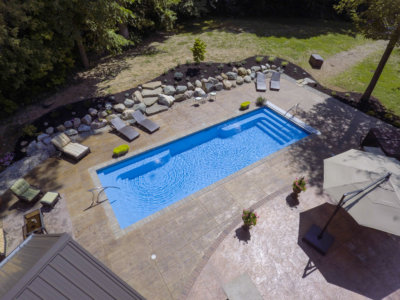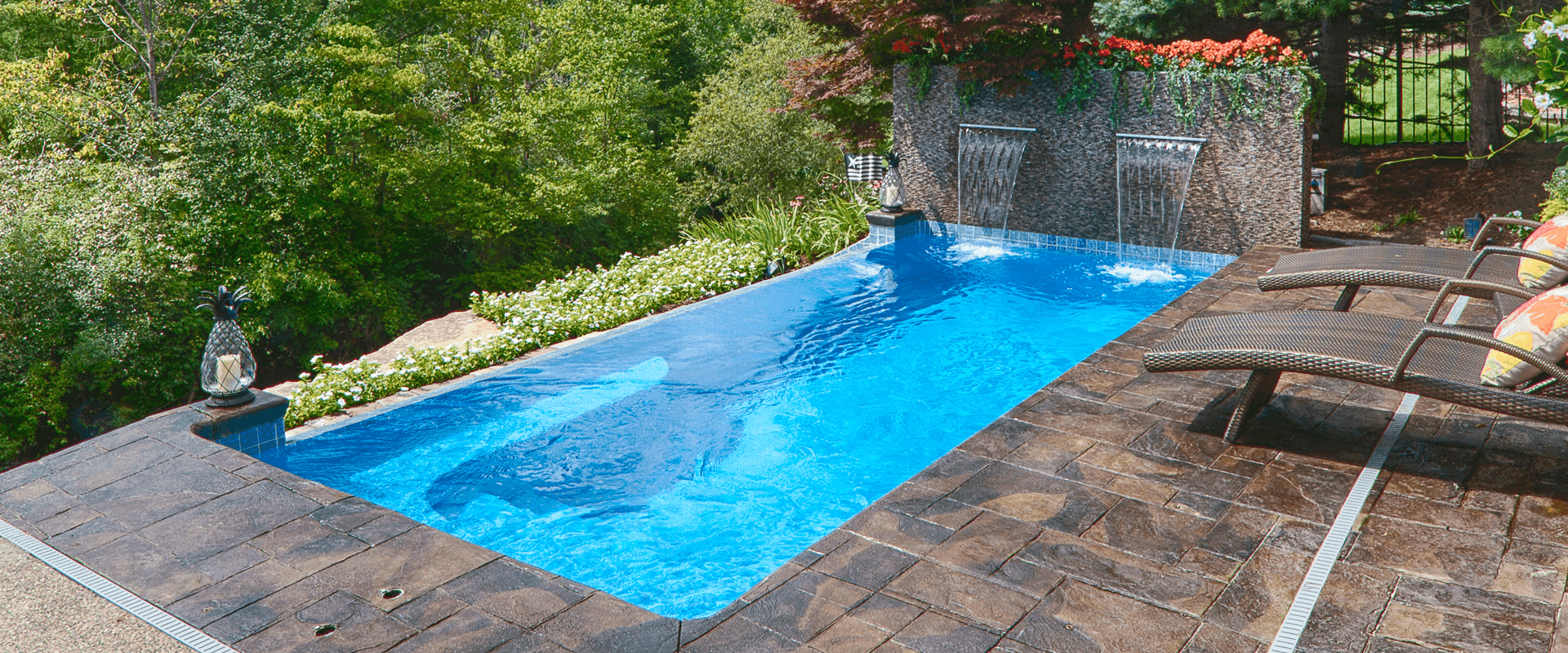877-929-7665
Fiberglass Pool vs. Vinyl Pool – Which is Better For You?

An inground pool is a big purchase—one that involves changing your living space and your current routines—so, of course, you want to understand all of your options (meaning vinyl vs. fiberglass vs. concrete pools). And if you’re here, it means you’ve either narrowed your choices down to vinyl or fiberglass or are attempting to do so. Either way, you’ve come to the right place. In this post, we’ll discuss a fiberglass pool vs vinyl pool.
Overview
Pros and Cons: Fiberglass vs Vinyl
Fiberglass
Pros:
Quick installation time
Most comfortable on your feet
Resistant to algae growth
High resale value
Pet Friendly
Cons:
Limited customization options
Higher upfront cost
Vinyl
Pros:
Low installation cost
Relatively quick to install
Resistant to algae growth
Customization
Cons:
More prone to damage/weathering
Harder to incorporate features, such as steps and tanning ledges
More financial investment over time
Low resale value
Not pet friendly
HOW THEY ARE MADE & INSTALLED
Both vinyl and fiberglass have relatively quick installation times, with vinyl about four to eight weeks and fiberglass about three weeks on average. An inground vinyl pool is 100% crafted on the job site, while fiberglass pool shells are manufactured at a designated facility based on a mold. Being created from a mold means more quality control and quicker installation. Once the pool shell is made and delivered, it is placed into the pre-dug hole and leveled. Following this are various processes, including plumbing, electrical equipment, decking, and coping.
Vinyl pool installation takes place directly on the job site, starting with the wall panels, which are typically constructed with steel or plastic. The pool floor is then made with poured concrete, and this also serves as a base for the walls to connect. A blend of vermiculite, cement, and water or a blend of sand, cement, and water is used to create the pool bottom. The entire surface is then covered with the vinyl liner and a vacuum is used to suction the liner into place. Plumbing, electrical equipment, decking, and coping follow suit.
HOW MUCH EACH POOL COSTS
Comparing vinyl pool cost to fiberglass pool cost is a fair comparison, as they both have lower upfront costs than a concrete pool would. However, vinyl liner pools can be less expensive than fiberglass by around $10 to 15,000. Fiberglass pricing will vary depending on many factors, so it’s always best to get a quote from an installation professional.
HOW LONG DOES EACH POOL TYPE LAST
The structure of a vinyl liner pool has the potential to last for decades, but the liner wears more quickly and is subject to tearing (especially if you have dogs who like to swim), so it will need to be replaced. Groundwater underneath the pool can cause other potential issues with the liner, such as floating. While one of the advantages of vinyl liner pools is their ability to be customized, customization also adds to the overall price of the pool. The unique shapes can also hike up repair prices as it becomes more complicated to overlay the liner. The likelihood of this pool type being damaged can also decrease your home’s resale value on the market.
When it comes to fiberglass, its rigid but flexible structure allows for maximum durability, meaning fiberglass pools can last a lifetime. This is where quality control in production really matters. Using a mold means fewer mistakes in the pool’s structure, and thick, even layers of gel coat make the pool more resistant to scratches and other surface damage. Innovations in fiberglass pool structures, such as the Backfill Eliminator™, help prevent groundwater accumulation and its associated issues. Maintenance and wear-and-tear repair end up costing you significantly less in the long run. And, in contrast to vinyl, fiberglass pools can increase your home’s value.
EACH POOL TYPE’S SAFETY
No matter which pool you choose, we will always shout from the rooftops: “Be careful! Accidents can happen!” Anyone entering or exiting a pool should practice caution. However, fiberglass does a great job of keeping swimmers of all shapes, sizes and species safe as they enter and exit the pool. Non-skid texture applied to the fiberglass pool’s horizontal surfaces along with its algae resistance make it less slippery, and therefore, safer. Features such as multiple entry and exit points, toe ledges and swim outs add both style and safety to a fiberglass pool, and are great for both kids (and pets!) who are learning to swim.
Vinyl pools provide a great, smooth surface for your feet that feels fantastic, but smooth plus water can equal dangerous slips and falls. The potential tears we mentioned before can also pose safety risks for your fur babies, so you’ll have to keep an eye out.
PROBLEMS WITH FIBERGLASS POOLS
So, what are the problems associated with fiberglass pools? Not to toot our own horn here, but fiberglass tends to fare well across the board when it comes to pool durability, maintenance, and safety. Where fiberglass falls short is in custom design and upfront costs. As mentioned previously, fiberglass pools are manufactured based on a mold, meaning that the design of that pool is set in stone. Along with the obvious customization options like shape and placement and design of features (i.e., steps or tanning ledges), fiberglass is also often limited in capacity. Fiberglass pools don’t get much wider than 16 feet and are generally less than 44 feet long (with some exceptions) due to transportation limitations, while pools built onsite can be much larger.
PROBLEMS WITH VINYL LINER POOLS
While vinyl pools have their perks, they also have their pitfalls. This is particularly true with regard to their durability and overall lifetime value. You can’t discuss the potential issues of a vinyl liner pool without strongly emphasizing their tendency to wear and tear by nature, meaning that the liners need to be replaced fairly often (8-12 years on average with excellent pool care). And because a liner can be torn or punctured, these pools are not the best option if you would like your pets to join you for a swim. It’s also important to consider if you want to have a tanning ledge or lounge area in your pool—these features are more difficult to incorporate into a vinyl pool design.
Both pool types have their advantages and disadvantages, so what you choose will depend on your situation and what you are looking for in a pool. If you are looking for a quick-to-install pool with boundless shape and size options and lower upfront costs, then a vinyl liner may be right for you. If you’re wanting a pool that’s lower maintenance, less likely to need repairs, quick to install, and is both comfortable and safe for you and your pets, then fiberglass is calling your name!
If you are leaning towards fiberglass, first of all, we’d just like to say, “Yay!” But more importantly, check out our resources that may help plan your pool journey. Our inground pool cost estimator can give you a ballpark amount for how much your pool project may cost, and our pool selector tool helps you discover which shape and size pool will best accommodate your needs. A local fiberglass pool dealer is always an excellent resource for any questions you may have and is always our number one recommendation.
